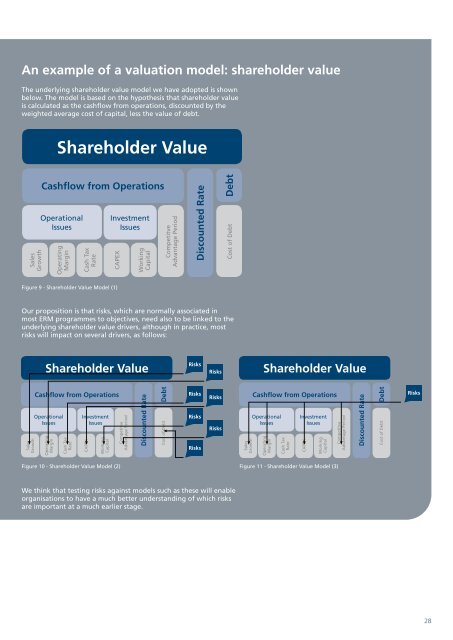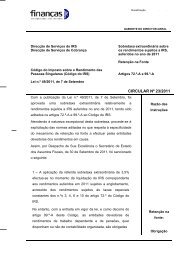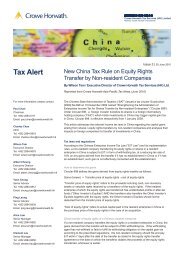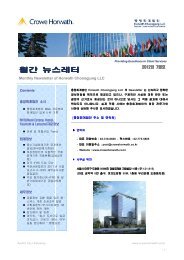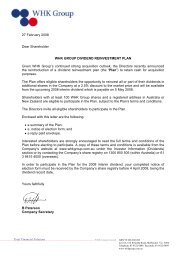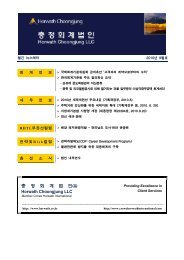Guidance Paper - The Institute of Risk Management
Guidance Paper - The Institute of Risk Management
Guidance Paper - The Institute of Risk Management
Create successful ePaper yourself
Turn your PDF publications into a flip-book with our unique Google optimized e-Paper software.
An example <strong>of</strong> a valuation model: shareholder value<br />
<strong>The</strong> underlying shareholder value model we have adopted is shown<br />
below. <strong>The</strong> model is based on the hypothesis that shareholder value<br />
is calculated as the cashflow from operations, discounted by the<br />
weighted average cost <strong>of</strong> capital, less the value <strong>of</strong> debt.<br />
Shareholder Value<br />
Sales<br />
Growth<br />
Cashflow from Operations<br />
Operational<br />
Issues<br />
Operating<br />
Margin<br />
Cash Tax<br />
Rate<br />
Investment<br />
Issues<br />
CAPEX<br />
Working<br />
Capital<br />
Competitve<br />
Advantage Period<br />
Discounted Rate<br />
Cost <strong>of</strong> Debt Debt<br />
Figure 9 - Shareholder Value Model (1)<br />
Our proposition is that risks, which are normally associated in<br />
most ERM programmes to objectives, need also to be linked to the<br />
underlying shareholder value drivers, although in practice, most<br />
risks will impact on several drivers, as follows:<br />
Shareholder Value<br />
<strong>Risk</strong>s<br />
<strong>Risk</strong>s<br />
Shareholder Value<br />
Sales<br />
Growth<br />
Cashflow from Operations<br />
Operational<br />
Issues<br />
Operating<br />
Margin<br />
Cash Tax<br />
Rate<br />
Investment<br />
Issues<br />
CAPEX<br />
Working<br />
Capital<br />
Competitve<br />
Advantage Period<br />
Discounted Rate<br />
Cost <strong>of</strong> Debt Debt<br />
<strong>Risk</strong>s<br />
<strong>Risk</strong>s<br />
<strong>Risk</strong>s<br />
<strong>Risk</strong>s<br />
<strong>Risk</strong>s<br />
Sales<br />
Growth<br />
Cashflow from Operations<br />
Operational<br />
Issues<br />
Operating<br />
Margin<br />
Cash Tax<br />
Rate<br />
Investment<br />
Issues<br />
CAPEX<br />
Working<br />
Capital<br />
Competitve<br />
Advantage Period<br />
Discounted Rate<br />
Cost <strong>of</strong> Debt Debt<br />
<strong>Risk</strong>s<br />
Figure 10 - Shareholder Value Model (2) Figure 11 - Shareholder Value Model (3)<br />
We think that testing risks against models such as these will enable<br />
organisations to have a much better understanding <strong>of</strong> which risks<br />
are important at a much earlier stage.<br />
28


